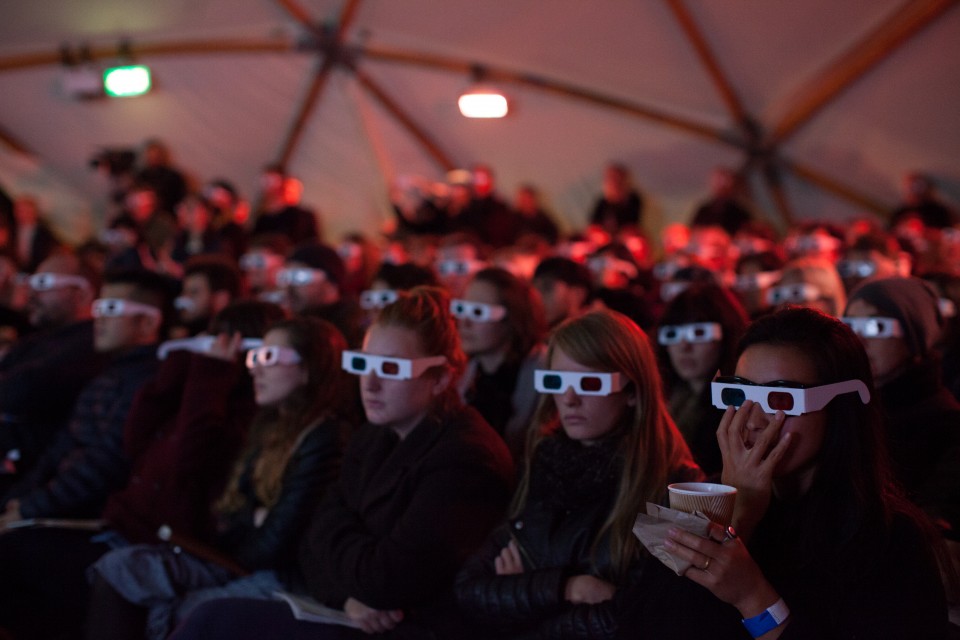Sebastian Groes
I belong to a profession whose business it is to protest against forgetting – but which also knows that memory is complex and sometimes dangerous. – Eric Hobsbawm, 10 May, 2012
On 12-14 October 2012 the Serpentine Gallery organised another Marathon – an unrelenting stream of a speakers offering diverse perspectives on one topic – memory, this time. The marathon was curated by Serpentine’s Hans Ulrich Obrist and held in memory of Eric Hobsbawm (1917-2012), who was supposed to attend but passed away on 1 October, aged ninety-five. The programme included scientists (Dimitar Sasselov), writers (John Berger, Douglas Coupland, China Miéville), academics (Marina Warner), film makers (David Lynch; Amos Gitai), musicians (Michael Stipe), dancers (Isabel Lewis), visual artists (Gilbert & George), actors (Tilda Swinton), and an olfactory specialist (Sissel Tolaas), amongst others. The contributors offered many different views, ranging from hardcore scientific explorations of memory to nostalgic musings about lost objects and traumatic cultural memory. You can find the full programme here: http://www.serpentinegallery.org/2012/10/memory_marathon.html
This is a half review as I only managed to get a ticket for the Sunday events, but it should give a good impression. It was a shame to have missed Marcus du Sautoy on memory and the mathematical mind; Luc Steels on the body and memory; Douglas Coupland (who misses his ‘pre-internet brain’); Colin MacCabe’s film with John Berger and Tilda Swinton; and, with the upcoming Proust Phenomenon in mind, Jean-Yves Tadié on the question whether there is such a thing as ‘involuntary memory’ and Sissel Tolaas on smell and memory. And I was very sorry to not have heard David Lynch, although the talk was probably about the benefits of transcendental meditation for world peace.
The well-spoken and thoughtful South African photographer David Goldblatt gave an excellent talk on his work, and the difficulty of using a two-dimensional space to capture a single moment in an enduring way; to freeze, in Goldblatt’s words, ‘imminence and immanence’. Much in his talk, and in his work, is implied, subtly.

David Goldblatt, The mill, Pomfret Asbestos Mine, Pomfret, North-West Province, 20 December 2002
Goldblatt showed photographs of South African mills and asbestos factories that are now monuments to an earlier industrial era; and he meditated on the idea of ‘shaft-sinking’ (one of the most dangerous parts of the mining industry) as a poignant metaphor for the role of history and testimony in addressing of South Africa’s troubled past and conscience: memory functions as personal and collective ‘working through’ of trauma. His series on ex-offenders is a profound meditation on former criminals grappling with memory, guilt, crime and punishment. Goldblatt’s work is artful, even sublime social documentary/commentary. You can find his work here: http://www.davidgoldblatt.com/.
In contrast to Goldblatt’s deeply humanist perspective stands the scientific narrative of Eyal Weizman (Visual Cultures, Goldsmiths). The author of Mengele’s Skull (2012) identified a shift in the study of social trauma from an emphasis on stories by victim of genocide towards forensic perspectives. He noted that the post-war period was ‘the era of testimony’ (think of South Africa’s Truth and Reconciliation Commission) and now we experience a move towards osteo-forensics and carbon-dating. Like people, material objects continually register time, transform and keep traces of their age and experience, but are probably more reliable: people misremember and misrepresent, objects don’t. It’s perhaps part of a more general forensic turn and perspective offered by science and technology in contemporary culture. Literary responses that come to mind are Ian McEwan’s work, but also Michael Ondaatje’s Anil’s Ghost (2000), which centres on a forensic anthropologist who works on the skeleton of a murdered man in Sri Lanka. Our contemporary culture has re-embraced material culture unconditionally, and we seem to be living through a new techno-scientific hyper-revolution that is reshaping our idea of what it means to be human. I do wonder whether we should challenge the overconfidence and sometimes blind belief in what seems another form of fallacious Enlightenment thinking.
Artistic duo Gilbert and George were very entertaining, spontaneously singing ‘Underneath the Arches’ (1932) in its entirety, but they also stated interesting, idiosyncratic things about memory. They are self-confessed hoarders, and have voluminous archives of any material object relating to their lives and art, including correspondence. They ended their appearance with an experiment undergone at the hands of a Belgian artist, who asked them to blurt out the first word that popped into their mind in response to the letters of the alphabet. It was a pornographic, scatological list, both amusing and profound at the same time because it reminded the audience that for Freud humans are archaeo-textual spaces that can be made sense of through excavation, or remembering, via linguistic association.
The octogenarian Japanese architect, Fumihiko Maki, who co-founded the Metabolist movement, delivered a compelling talk on the relationship between memory and architecture – he narrated his own life through the various spaces he made throughout his architectural career. Uncannily, Maki kept on alluding to his own impending death, and his exposition on his design for a crematorium was therefore alarming.

Fumihiko Maki’s Kaze no Oka Crematorium. Photo: Toshiharu Kitajima
In his Kaze-no-Oka Crematorium in Nakatsu, Maki has re-invented the traditional crematorium as a ‘transition space’, a spatial story which the mourners move through. Instead of going into the auditorium to say a final farewell and moving back out, the mourners pass through various rooms and receive the ashes in a beautiful garden at the back of the building. Rather than having the sense of returning to the world alone, you move on, with the deceased. This turns the departure of a loved one into a narrative with a happy ending, into a comforting future memory. Aristotle would approve. (In passing, Maki also noted something culturally very specific about Japan and memory: his grandfather had licked a fingerful of ashes of his cremated uncle, presumably to embody the lost relative.)
It is a shame that audience participation is limited at this Marathon; the general public is not allowed to ask questions. The most dangerous moment came when police artist Jan Szymczuk spoke about his work on crime scenes and drawing faces from witnesses’ memories. Szymczuk talked about ‘working memory’ in relationship to daily routine, which allows us to function on a day to day level without taking up much brain energy (can you remember what you had for dinner two days ago, or what you say on the bus to work yesterday? Probably not.) Unless the fabric of everyday reality is violently ruptured through some kind of accident, and then the brain actually remembers actively. He spoke of a twenty-four hour window, when the imprint of the memory was freshest, making it necessary to interview victim of crime (other than sexual assault) at that point. Suddenly, a young woman in the audience jumped up and shouted: ‘How can you sit there and tells these f***ing lies? You should know better, knowing what you know?” She then stormed out, leaving a dumbstruck audience behind – we were trying to figure out what the woman had said precisely and how it related to Szymczuk. Was she a victim of sexual assault? Why this attack on this man, who dedicates his life to solving crime? Szymczuk said: “Did you get a look at that woman? Would you be able to describe her to me?” The woman’s intervention was part of Szymczuk’s demonstration of how such a violent, verbal intrusion can jolt memory from ‘working memory’ into ‘active memory’: the senses are blown open and we absorb the world around us more intensely, more fully. Szymczuk then asked a volunteer to help him reconstruct a drawing of the woman’s face from memory. Brilliant.
Alice Rawsthorn (http://www.alicerawsthorn.com/) delivered a talk on why certain objects disappear: it’s the combination of ‘functionality’ and ‘aesthetic quality’ (ie. design) that ensures survival. As an example she noted the disappearance of the calculator, in the seventies a new, magical tool, whose functionality and look are now absorbed into the computer and mobile phone. Rawsthorn made a claim for the survival of the printed book, but there are good reasons for believing in the future of the book as material object besides nostalgia, as Mary Wolf’s Proust and the Squid (2007) and Nicolas Carr’s The Shallows (2011) make clear.
China Miéville and Evan Calder Williams echoed Rawsthorn’s concerns in a macho, militant Salvagepunk tract, which argues for ‘a return to the repressed idiosyncrasy of outmoded things’ in a hypercapitalist world of excess, consumption and waste. Essentially, salvagepunk (excuse le mot) recycles the well-trodden wastelandian, post-apocalyptic excremental lineage: Marx, Freud, T. S. Eliot, Benjamin, Baudrillard. But their talk had little to do with the role of memory (or the lack of it) in society, nor was there (except for a fleeting reference to Benjamin’s Angel of History) the sustained deep historical thinking of Hobsbawm which we need in our culture of spectacle and surfaces they quite rightly attack. You can find a similar talk by Miéville and Williams here: http://wastedideology.blogspot.co.uk/2011/08/incredibly-important-talk-from-evan.html
An Italian artist, Alberto Garutti, spoke through a translator after disseminating slips of paper that read: every step that I have taken in my life has brought me here, now. An unintelligible argument followed, and Garutto constructed an image of memory that was too much like a unilinear chain, too much steeped in causality. A discussion between Amos Gitai, Jacques Herzog and Pierre de Meuron hardly touched on memory at all, but turned into a discussion of the importance of collaboration, and despite various attempts by moderator Obrist, the men remained schtum about memory.
There was one original contribution, though, which besides Szymczuk’s intervention was the highlight of the day. Dancer-performer Isabel Lewis spoke about dance, muscle memory and embodied memory from a practitioner’s perspective. Not only did she make useful connections between memory and technologies we don’t think of as technologies (such as stretch jeans, which made break-dancing possible), but Lewis also reinterpreted the etymology of memory itself, suggesting that we could think of memory as ‘re-membering’, as ‘re-limbing’ or ‘re-living’. That is useful and creative, and poses interesting questions about somatic memory. Lewis also showed various clips of dances, including the ‘Tectonic’: http://www.youtube.com/watch?v=s1TVrNFFQaE. What is happening here, in (to?) this dancer’s mind and body? Is she remembering these moves? Much of the dance is improvised, and a world away from classic ballroom dancing, with its formal coding and patterning of the body in space. How do we ‘read’ the relationship between mind and body? Scientific evidence is not conclusive as to whether ‘muscle memory’ actually exists, and it might just be the brain that remembers dance moves (which would explain that you never forget how to ride a bike or ski). But beyond these scientific and philosophical ruminations, the literary mind cannot help but look towards poetry for an answer. The final stanza of W. B. Yeats’s poem ‘Among School Children’ (1928) goes as follows:
Labour is blossoming or dancing where
The body is not bruised to pleasure soul.
Nor beauty born out of its own despair,
Nor blear-eyed wisdom out of midnight oil.
O chestnut-tree, great-rooted blossomer,
Are you the leaf, the blossom or the bole?
O body swayed to music, O brightening glance,
How can we know the dancer from the dance?
The dancer is indistinguishable from her dance; she is the dance, object and creator, mediated by us as spectators. What we see in the performance is how bodily form and function collapse into pure, yet controlled being, the illusion of freedom and potentially endless permutation. The mind and body duality is effaced, and the consciousness becomes at one with the body in the experience.
Throughout the Marathon, the absence of the great historian, Hobsbawm, himself, was striking. The above epigraph is now an epitaph, and an important reminder for all of us to work and live against the corrosive powers of forgetting. More information on the Memory Marathon can be found here:http://www.serpentinegalleries.org/exhibitions-events/memory-marathon




